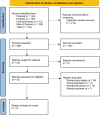Unilateral Versus Bilateral Deep Inferior Epigastric Perforator Flap Breast Reconstruction: A Systematic Review and Meta-analysis
- PMID: 39640216
- PMCID: PMC11620719
- DOI: 10.1097/GOX.0000000000006359
Unilateral Versus Bilateral Deep Inferior Epigastric Perforator Flap Breast Reconstruction: A Systematic Review and Meta-analysis
Abstract
Background: Previous studies have shown a higher complication rate in bilateral (BL) compared to unilateral (UL) deep inferior epigastric perforator (DIEP) flap breast reconstructions. This systematic review and meta-analysis aimed to offer an update by including recent studies to thoroughly assess the complication rates in UL versus BL DIEP flap reconstructions and provide clear guidance for clinicians and their patients.
Methods: A systematic review of the literature and comparative meta-analysis were performed to assess the differences in complication rates between UL and BL procedures. Only comparative studies that reported on postoperative complications after UL and BL DIEP flap breast reconstructions were included. Odds ratios (ORs) and 95% confidence intervals (CIs) were calculated using a random-effects model.
Results: Five studies representing 5120 patients who underwent either UL or BL DIEP flap breast reconstructions were included. BL DIEP flap reconstructions were associated with a higher risk of total flap loss, with an OR of 1.48 (95% CI, 1.02-2.14) and a P value of 0.04. Conversely, the risk of reexploration surgery was reduced, with an OR of 0.68 (95% CI, 0.55- 0.84) and a P value of 0.0002.
Conclusions: BL DIEP flap breast reconstruction carries a higher risk of complete flap loss compared with UL reconstructions, with a moderate risk increase. Despite this increased risk, the significant benefits of BL reconstruction make it a viable and recommended option for women requiring this type of surgery.
Copyright © 2024 The Authors. Published by Wolters Kluwer Health, Inc. on behalf of The American Society of Plastic Surgeons.
Conflict of interest statement
The authors have no financial interest to declare in relation to the content of this article.
Figures
References
-
- Tuttle TM, Habermann EB, Grund EH, et al. . Increasing use of contralateral prophylactic mastectomy for breast cancer patients: a trend toward more aggressive surgical treatment. J Clin Oncol. 2007;25:5203–5209. - PubMed
-
- Han E, Johnson N, Glissmeyer M, et al. . Increasing incidence of bilateral mastectomies: the patient perspective. Am J Surg. 2011;201:615–618. - PubMed
-
- Stucky CCH, Gray RJ, Wasif N, et al. . Increase in contralateral prophylactic mastectomy: echoes of a bygone era? Ann Surg Oncol. 2010;17:330–337. - PubMed
-
- Hu ES, Pusic AL, Waljee JF, et al. . Patient-reported aesthetic satisfaction with breast reconstruction during the long-term survivorship period. Plast Reconstr Surg. 2009;124:1–8. - PubMed
-
- Yueh JH, Slavin SA, Adesiyun T, et al. . Patient satisfaction in postmastectomy breast reconstruction: a comparative evaluation of DIEP, TRAM, latissimus flap, and implant techniques. Plast Reconstr Surg. 2010;125:1585–1595. - PubMed
LinkOut - more resources
Full Text Sources




